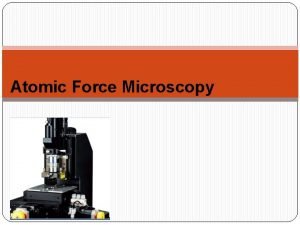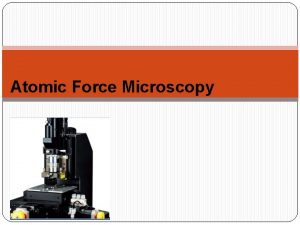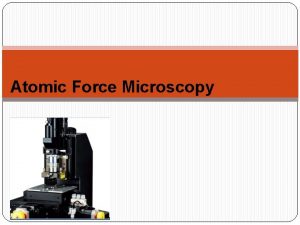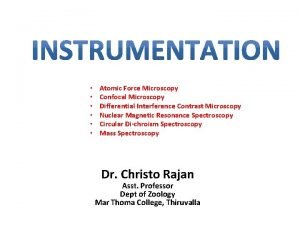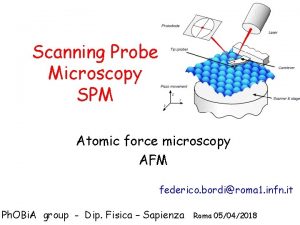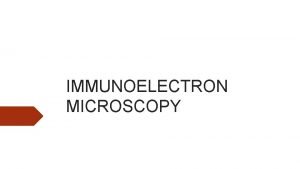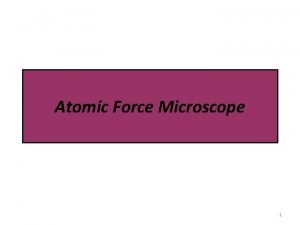Fluid Interface Atomic Force Microscopy FIAFM D Eric












- Slides: 12

Fluid Interface Atomic Force Microscopy (FI-AFM) D. Eric Aston Prof. John C. Berg, Advisor Department of Chemical Engineering University of Washington

Fluid Interface AFM (FI-AFM) Gain knowledge about oil agglomeration and air flotation through studies of single particle/oil-drop interactions. Oil Agglomeration Air Flotation Quantify the influence of non-DLVO forces on colloidal behavior: Colloidal AFM 1. Hydrophobic attraction 2. Hydrodynamic repulsion 3. Steric, depletion, etc. Ultimately, standardize an analytical technique for colloidal studies of fluid-fluid interfaces with AFM.

Objectives for Deforming Interfaces Determine drop-sphere separation with theoretical modeling. Dzc S=? Dzd Oil kc · Dzc = F F(S) kd(Dzd) · Dzd = F Dz Proper accounting of DLVO and hydrodynamic effects hydrophobic effects steric effects Interfacial tension effects

AFM Experimental Design Direct interfacial force measurements with AFM. Photodetector Optical objective He-Ne laser Water Glass walls Oil x-y-z Scanner Prove AFM utility based on theoretical modeling. Classic Force Profile F/R Force AFM F(z) Data Displacement (mm) Separation (nm)

Exact Solution for Droplet Deformation Drop profile calculated from augmented Young-Laplace equation: includes surface and body forces. The relationship between drop deflection and force is not fit by a single function. AFM probe r F z P(z(r)) D(r) Do Po k(r, z) fluid medium

Qualitative Sphere-Drop Interactions Several properties affect drop profile evolution: 1. Initial drop curvature 2. Particle size 3. Interfacial tension Water Oil 4. Electrostatics 5. Approach velocity Liquid interface can become unstable to attraction. DP = Po DP > Po Drop stiffness actually changes with deformation: • Weakens with attractive deformation. • Stiffens with repulsive deformation.

Long-Range Interactions in Liquids van der Waals interaction - usually long-range attraction. Includes hard wall repulsion Electrostatic double-layer - often longer-ranged than dispersion forces. Moderately strong, asymmetric double-layer overlap Hydrodynamic lubrication - Reynolds pseudo-steady state drainage. * Added functionality for varied boundary conditions Hydrophobic effect - observed attraction unexplained by DLVO theory or an additional, singular mechanism. Empirical fit

Theoretical Oil Drop-Sphere Interactions Drop Stiffness Film Thickness Drop radius, Rd decreases constant Particle radius, Rs increases Approach velocity, |v| increases Interfacial tension, s increases decreases Electrolyte conc. ~constant decreases Surface charge, ~constant increases As These Increase Polysytrene/Hexadecane in Salt Solutions Rd = 250 mm Rs = 10 mm A 132 = 5 x 10 -21 J = = -0. 25 m. C/cm 2 [Na. NO 3] |v| = 100 nm/s s = 52 m. N/m

Oil-PS Experimental Profiles Rd = 250 mm Rs = 10 mm A 132 = 5 x 10 -21 J = = -0. 32 m. C/cm 2 |v| = 120 nm/s s = 52 m. N/m 0. 1 m. M Na. NO 3 Hydrophobic effect C 1 = -2 m. N/m l = 3 nm

Dynamic Interfacial Tension - SDS • Oil-water interfacial tension above the CMC for SDS decreases with continued deformation of the droplet. 6 m. N/m Fit

Oil Drop with Cationic Starch Adlayers • Cationic starch electrosterically stabilizes against wetting. • Even at high salt, steric hindrance alone maintains stability. DP = Po DP < Po Long-range attraction without wetting = depletion? 0. 1 M Na. NO 3 • What is the minimum adlayer condition for colloid stability? • Why does cationic starch seem not to inhibit air flotation?

Conclusions • Expectation of a dominant hydrophobic interaction is premature without thorough consideration of the deforming interface. • Several system parameters are key for interpreting fluid interfacial phenomena, all affecting drop deformation. 1. Surface forces - DLVO, hydrophobic, etc. 2. Drop and particle size - geometry of film drainage 3. Interfacial tension - promotion of film drainage 4. Approach velocity - resistance to film drainage • FI-AFM greatly expands our ability to explore fluid interfaces on an ideal scale.
 Data recovery techniques
Data recovery techniques Is atomic mass and relative atomic mass the same
Is atomic mass and relative atomic mass the same Periodic trend
Periodic trend Atomic radius periodic table
Atomic radius periodic table Is atomic mass and relative atomic mass the same
Is atomic mass and relative atomic mass the same Difference between atomic number and atomic mass
Difference between atomic number and atomic mass Atomic number vs atomic radius
Atomic number vs atomic radius Is synovial fluid extracellular fluid
Is synovial fluid extracellular fluid Fluid statics deals with fluid at rest
Fluid statics deals with fluid at rest Fluid statics deals with
Fluid statics deals with Transcellular fluid compartment
Transcellular fluid compartment Bioimpedância
Bioimpedância Interstitial fluid vs extracellular fluid
Interstitial fluid vs extracellular fluid













